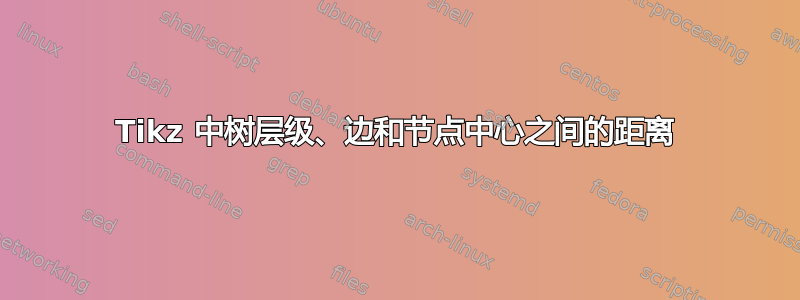
级别距离似乎对下面 MWE 中第一个节点与其子节点的距离没有任何影响(尝试level distance在每个级别添加和使用它的值,但它只适用于 levelX 样式):
\documentclass[10pt]{article}
\usepackage[utf8]{inputenc}
\usepackage[landscape,paper=ansibpaper]{geometry}
\usepackage{tikz}
\usetikzlibrary{trees}
\usetikzlibrary{shadings}
\tikzstyle{every node}=[draw=black,thin,anchor=west, minimum height=2.5em]
\begin{document}
\begin{figure}[!htb]
\resizebox{\linewidth}{!}{
\begin{tikzpicture}[
supervisor/.style={%
edge from parent fork down,
level distance=2.5cm,
text centered, text width=5cm},
teammate/.style={%
text centered, text width=3cm,
level distance=2.5cm,
fill=gray!10},
subordinate/.style={%
grow=down, xshift=-1.1cm, % Horizontal position of the child node
text centered, text width=3cm,
edge from parent path={(\tikzparentnode.205) |- (\tikzchildnode.west)}},
level1/.style ={level distance=1.5cm},
level2/.style ={level distance=3cm},
level3/.style ={level distance=4.5cm},
level4/.style ={level distance=6cm},
level5/.style ={level distance=7.5cm},
level 1/.style={sibling distance=4cm}
]
% \draw[help lines] (0,0) grid (4,3);
% Supervisor
\node[anchor=south,supervisor]{Supervisor\\Supervisory position\\Location}
[edge from parent fork down]
% Teammate and Subordinates
child{node [teammate] {Teammate1\\Position1\\Location1}
child[subordinate,level1] {node {Subordinate\\Position1\\Location1}}
child[subordinate,level2] {node {Subordinate2}}
child[subordinate,level3] {node {Subordinate3}}
child[subordinate,level4] {node {Subordinate4\\Position4\\Location4}}
child[subordinate,level5] {node {Subordinate5\\Position5\\Location5}}}
%
child{node [teammate] {Teammate2\\Position2\\Location2}
child[subordinate,level1] {node {Subordinate1}}
child[subordinate,level2] {node {Subordinate2}}
child[subordinate,level3] {node {Third\\Teammate}}
child[subordinate,level4] {node {Longtext-\\teammate}}}
%
child{node [teammate] {Teammate3\\Position3\\Location3}
child[subordinate,level1] {node {Subordinate\\two lines}}
child[subordinate,level2] {node {Subordinate2}}
child[subordinate,level3] {node {Subordinate3}}}
%
child{node [teammate] {Teammate4\\Position4\\Location4}
child[subordinate,level1] {node {Subordinate1}}
child[subordinate,level2] {node {Subordinate2}}}
%
child{node [teammate] {Teammate5\\Position5\\Location5}
child[subordinate,level1] {node {First\\Subordinate}}
child[subordinate,level2] {node {Subordinate2}}
child[subordinate,level3] {node {Third\\Teammate}}
child[subordinate,level4] {node {Longtext-\\teammate}}};
%\shade[shading=Mandelbrot set] (0,0) rectangle (5,5);
\end{tikzpicture}}
\caption{This is an org chart}
\end{figure}
\end{document}
我究竟做错了什么?
附加问题:是否可以将主管的盒子水平置于中央?
答案1
您可以使用
level 1/.append style
一个例子:
\documentclass[10pt]{article}
\usepackage[utf8]{inputenc}
\usepackage[landscape,paper=ansibpaper]{geometry}
\usepackage{tikz}
\usetikzlibrary{trees}
\usetikzlibrary{shadings}
\tikzstyle{every node}=[draw=black,thin,anchor=west, minimum height=2.5em]
\begin{document}
\begin{figure}[!htb]
\resizebox{\linewidth}{!}{
\begin{tikzpicture}[
supervisor/.style={%
edge from parent fork down,
level distance=2.5cm,
text centered, text width=5cm},
teammate/.style={%
text centered, text width=3cm,
level distance=2.5cm,
fill=gray!10},
subordinate/.style={%
grow=down, xshift=-1.1cm, % Horizontal position of the child node
text centered, text width=3cm,
edge from parent path={(\tikzparentnode.205) |- (\tikzchildnode.west)}},
level1/.style ={level distance=1.5cm},
level2/.style ={level distance=3cm},
level3/.style ={level distance=4.5cm},
level4/.style ={level distance=6cm},
level5/.style ={level distance=7.5cm},
level 1/.style={sibling distance=4cm},
level 1/.append style={level distance=4.5cm},
]
% \draw[help lines] (0,0) grid (4,3);
% Supervisor
\node[anchor=south,supervisor]{Supervisor\\Supervisory position\\Location}
[edge from parent fork down]
% Teammate and Subordinates
child{node [teammate] {Teammate1\\Position1\\Location1}
child[subordinate,level1] {node {Subordinate\\Position1\\Location1}}
child[subordinate,level2] {node {Subordinate2}}
child[subordinate,level3] {node {Subordinate3}}
child[subordinate,level4] {node {Subordinate4\\Position4\\Location4}}
child[subordinate,level5] {node {Subordinate5\\Position5\\Location5}}}
%
child{node [teammate] {Teammate2\\Position2\\Location2}
child[subordinate,level1] {node {Subordinate1}}
child[subordinate,level2] {node {Subordinate2}}
child[subordinate,level3] {node {Third\\Teammate}}
child[subordinate,level4] {node {Longtext-\\teammate}}}
%
child{node [teammate] {Teammate3\\Position3\\Location3}
child[subordinate,level1] {node {Subordinate\\two lines}}
child[subordinate,level2] {node {Subordinate2}}
child[subordinate,level3] {node {Subordinate3}}}
%
child{node [teammate] {Teammate4\\Position4\\Location4}
child[subordinate,level1] {node {Subordinate1}}
child[subordinate,level2] {node {Subordinate2}}}
%
child{node [teammate] {Teammate5\\Position5\\Location5}
child[subordinate,level1] {node {First\\Subordinate}}
child[subordinate,level2] {node {Subordinate2}}
child[subordinate,level3] {node {Third\\Teammate}}
child[subordinate,level4] {node {Longtext-\\teammate}}};
%\shade[shading=Mandelbrot set] (0,0) rectangle (5,5);
\end{tikzpicture}}
\caption{This is an org chart}
\end{figure}
\end{document}



